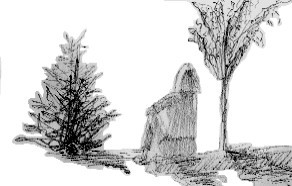 The boys and I went to a park today. Twice. The first time, Jacob had his old three-wheeling bike. Time for an upgrade - so we went to target and bought a two-wheeler. He'll be my last child to learn bicycling from me. Sigh... But when we went to the park, I took my sketchbook with me. A woman and her family were at the playground, and I did a fast rough sketch of her and the two trees that bookended her. I've come to believe that sketching is vital to my art. I need to practice, every day if possible. Earlier in the day, Cub and Nick and I went to Barnes & Nobles and I bought The Ultimate Book of Sketching. It's out of print, but B & N had four copies of it. It's a decent book, not so much on method, but for all of the examples the artists display. I've finished Richard Schmid's book on painting. Truly great book. I've tried my hand at painting and I've never had any formal training, so I've been reading voraciously to give me as much of the essence of it as I can muster on my own. Major influences so far would be Schmid, a watercolorist named David Becker, and Betty Edwards, who wrote Drawing on the Right Side of the Brain and her book on color. The good thing about the three of them is how much they disagree with each other. Becker's watercolors are effortless. He's what I would term a natural artist. Obviously, his "natural" ability is well-honed and practiced. He's a huge advicate of sketching and believes deeply in using initial sketches as a blueprint for composition and values (depth of darkness/brightness). He's unafraid to change a picture to get a better composition. He'll add people, change buildings, and completely ignore the picture's original colors to arrive at what he feels is the best and most interesting painting. Then there's Schmid, whose method is Alla Prima, or paint what you see in one sitting. He doesn't change colors. He paints it as it is, and he's quite ardent about that. Schmid's theory about color is to find a pallete that is true and then learn to blend the colors. He has a fantastic color chart near the end of the book that show how the colors of his pallette blend with each other, and he insists that everyone do this. I see wisdom in this and I'll be doing that myself in the next week or two. He goes into some depth about form (the shape of objects), value (the shading of objects), colors, and edges (the way in which colors and forms meet each other in a painting). Schmid's compositions are fairly straightforward - the subject of the painting is generally at the center and not surrounded by much else. He emphasizes the skill of drawing, like Becker. But he couldn't disagree more with Becker and Edwards about color. Becker and Edwards talk about color harmony. Becker's favorite three colors are purple, green, and yellow-orange; you see them prominently in just about every painting he does. Edwards spends a great deal of time in her book on color discussing how we naturally see harmony in certain colors. Schmid says that's all bullshit. He believes that lighting forces everything into a harmony of sorts. For example, moonlight will blend everything into a pleasant harmony under its spectrum. Sunlight, same thing. I like both perspectives on the subject. I'm too new at this to really have an opinion yet, but again, I'm busy fact-gathering to be as effective as I can be. Where Schmid really differs with the other two is on the topic of edges, and you can really see this in his paintings as well. I've browsed a lot of art books in trying to find ones that would help me understand better and enhance my work to bring out best what it is that I can do. Schmid's comprehensive treatment of edges is unique. Even he says as much in his book. Becker goes into edges a little in one book that I have, but I think watercolors are meant to blend more so that oil can. So are edges in watercolor not as important? I don't know. I do know that Schmid's work is amazing for what it achieves. The idea that he does his paintings, in oil, in a day knocks my socks off. So I've been thinking about all of this. My version of art training... and now my book on sketching to browse and keep me motivated.  I have noticed that drawing from life is much harder than drawing from a photo. The photo comes with measurable sides and it's easier to get a sense of the shapes. Real life is much more difficult. Here again, this is Schmid's forte. His subjects sit in front of him, whether a landscape or a person. That's brave, in my opinion. So I'm convinced that I need to skecth from real life more often. The preceding sketch is of a car in a parking lot near where I live. Did I capture it? I don't know - I don't think it really matters. It's like a friend of mine likes to say, it's not success or failure that defines us but the journey. Now it's time to make dinner on this gorgeous day :) |